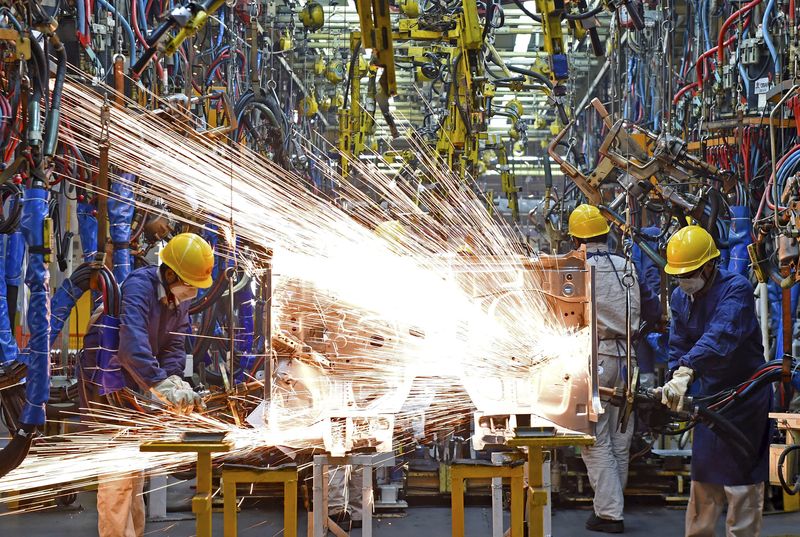By Jonathan Cable and Nicholas Owen
LONDON/JAKARTA (Reuters) - Manufacturing activity deteriorated across much of Asia in November and while European factories reports improved, the region struggled to gather momentum.
Business surveys on Tuesday showed few signs of vigour across trade-reliant Asia, apart from Japan, with sluggish demand at home and abroad forcing manufacturers from China to Indonesia to throttle back production, cut selling prices and shed more jobs.
Euro zone manufacturing growth picked up to a 19-month high in November but the pace was still relatively modest and with firms cutting prices for a third month, expectations for further easing from the European Central Bank on Thursday will solidify.
"The deal has been sealed for the ECB, markets have moved after the very strong hints and one data point wouldn't change its mind at this stage," said Jennifer McKeown at Capital Economics. "These particular data anyway aren't all that encouraging. There is just no real inflationary pressure."
As part of its battle to boost inflation - nowhere near the Bank's 2 percent target ceiling at just 0.1 percent - the central bank has been buying 60 billion euros (£42.1 billion) a month of mostly government bonds since March.
Official data showed euro zone unemployment fell slightly more than expected in October and Markit's final manufacturing Purchasing Managers' Index rose to 52.8 in November, above the 50 mark that separates growth from contraction but not vigorous given the amount of stimulus.
With firms cutting prices for a third month, there was little to conflict with the findings in a Reuters poll last week that suggested the ECB would expand and extend its quantitative easing programme when policymakers meet on Thursday. [ECB/INT]
The ECB is also highly likely to cut its deposit rate further into negative territory, effectively increasing the amount banks have to pay to park money overnight.
Just as global policymakers and investors are factoring in that extra easing from the ECB, they are bracing themselves for the first hike in U.S. rates since 2006, which most analysts see coming at the Federal Reserve's Dec. 15-16 meeting. [ECILT/US]
British manufacturing growth slowed last month from the rapid pace recorded in October. And in the latest in a long line of relatively upbeat data, a similar survey due from the U.S. later on Tuesday is expected to show a slight pick-up.
DESPONDENT ASIA
There was little in Asia's survey numbers to cheer about.
"Asia's economy looks decidedly wobbly going into year-end. Exports continue to struggle amid sluggish demand in the West and other emerging markets," said HSBC economist Frederic Neumann.
China's official PMI fell for a fourth month in a row in November, hitting its lowest since August 2012, as new export orders dropped for the 14th month.
A private survey, the Caixin/Markit China PMI, which focuses on small and mid-sized companies, edged up to its highest reading since June, but still pointed to a ninth month of contraction.
However, a pickup in services activity in a similar official survey offered some hope the sector would offset persistent weakness in "old economy" growth drivers such as manufacturing.
Facing what could be its slowest pace of economic expansion in a quarter-century, China has slashed interest rates six times in the past year as part of sweeping stimulus efforts, and more easing is expected next year.
While the moves may have reduced the risk of a so-called hard landing for the economy, so far they have yet to show signs of re-energising demand.
"With soft growth momentum and deflation pressures creeping up, we expect the authorities to further ease monetary policy and continue to implement an expansionary fiscal policy," said economists Li-Gang Liu and Louis Lam at ANZ bank.
Meanwhile, in the first indication of how Asian trade performed in November, South Korea's exports fell 4.7 percent from a year earlier, the 11th month of contraction.
There was much better news out of Japan, where manufacturing firms, possibly aided by a weak yen, may be producing enough to lift the world's third-largest economy out of recession.
Manufacturing production expanded by its fastest pace in 20 months in November as new orders picked up, according to the Markit/Nikkei Japan manufacturing PMI.
With financial markets on edge ahead of any repercussions should the Fed go ahead and raise rates, Asian central banks are for the most part staying pat for now while hinting there is room to ease further if conditions do not improve next year.

Both Australia's Reserve Bank and the Reserve Bank of India held rates on Tuesday in widely-expected moves.